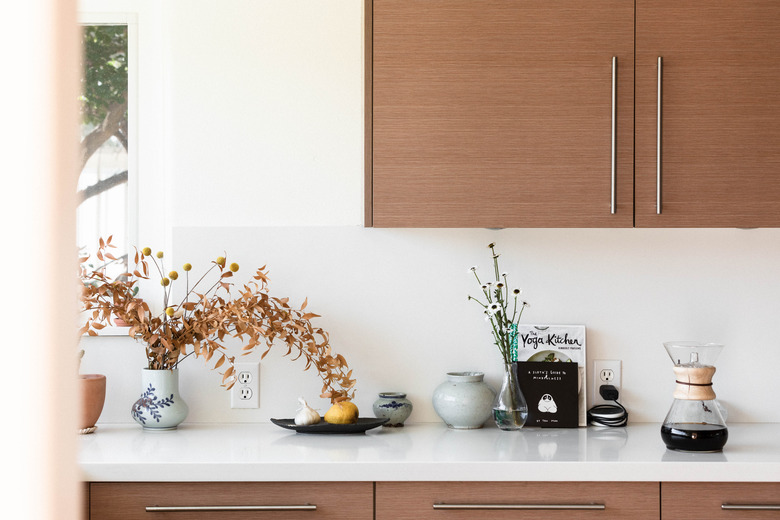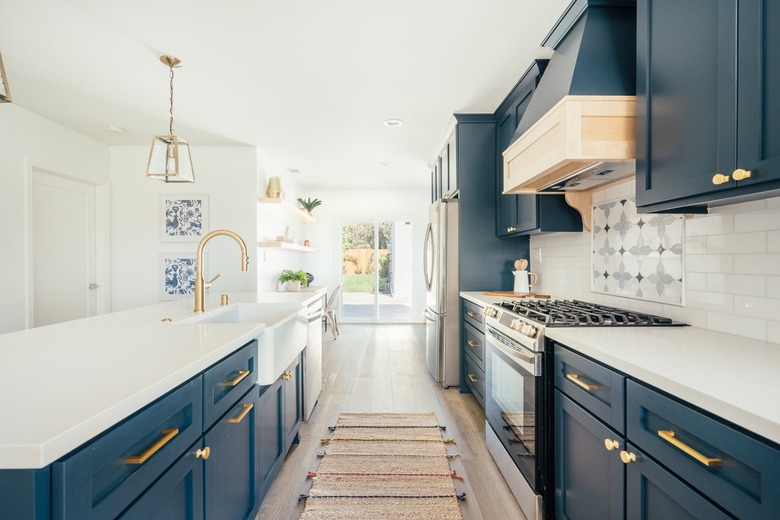Kitchen Cabinets: A Homeowner's Guide
We may receive a commission on purchases made from links.
Choosing kitchen cabinets can be overwhelming. Imagine plucking your great-great-grandparents out of history and dropping them off in a modern grocery store along with your family's shopping list and instructions to make the perfect choice for each item. If the toothpaste aisle doesn't do them in, the laundry soap options certainly will.
That's how cabinet shopping can feel. It's not enough that you have to choose the right material, type, style and size of cabinets; you should also know how the drawers are constructed and how well the finish will stand up to cleaning.
To be sure, picking cabinets is a big, complex decision. On the other hand, it's a lot of fun. New kitchen cabinets can cost as much as a furnace or even a new roof or driveway, but you'll get infinitely more satisfaction from your cabinets. Not only will they overhaul the look of your kitchen but they'll improve the way it functions every day of the year.
When you're ready to get started, plan for plenty of time to research your options and to comparison shop both in town and online. Not to add pressure, but the success of your kitchen remodel depends on it.
How to Choose Kitchen Cabinets
How to Choose Kitchen Cabinets
There's no standard plan or secret weapon for choosing the right cabinets, but there's definitely a wrong way to go about it, and that is not learning about your options. If you do nothing more than visit your local home center or a kitchen showroom and leave with a receipt in your hand, you might make a regrettable decision.
While a home center staff designer or a kitchen showroom or design firm can tell you a great deal about the world of cabinets, they can represent only a small portion of that world in terms of product offerings and certainly in terms of price. That said, talking with an expert is a great way to get an introduction to what lies ahead and even to get a ballpark sense of what it might cost.
When you visit a local cabinet retailer, pick up a few catalogs from big cabinet manufacturers. These are great resources for learning about standard options for sizes, materials, features, cabinet shapes and styles and specialty cabinets. Most large cabinet companies have similar offerings in all of these categories.
After you learn the functional and cosmetic basics of kitchen cabinets, including types, materials, construction and general styles, your next step is to decide roughly how much you want to spend. This will help you narrow the field of options and focus on the elements and features about which you really care.
With your budget and general preferences established, designing your cabinets is mostly a matter of picking the units to fit your space. Remember to keep function — how you use your kitchen most often — at the top of your mind.
Kitchen Cabinet Types
Kitchen Cabinet Types
There are three general types or categories of cabinets: stock, semicustom and custom. More than anything, the categorization relates to available options and to what degree you can personalize your cabinet order. Secondarily (and not always reliably), each group represents a different level of quality. To get an idea of cabinet pricing, measure the total length of the cabinet area in your kitchen. Most kitchens have 25 to 30 feet of cabinets, according to Consumer Reports.
Stock cabinets are products that are sold off the shelf from a home center, cabinet supplier or furnishings retailer. They tend to be the least-expensive cabinets, and they're readily available at the store, but they also come with the fewest options for size, style, materials and features. This category includes everything from boring, builder-grade oak cabinets to nicer hardwood or laminate units that rival some semicustom offerings. The cost of stock cabinets starts at about $70 per foot.
Semicustom cabinets are what homeowners use most often when remodeling their kitchen. This is because semicustom offers the best compromise between options and price. You usually buy them from a catalog, and you may have to wait several weeks to receive your cabinets. All but the most demanding shoppers will find just what they need in the semicustom realm. Costs start at about $150 per foot.
Custom cabinets are tailored to your exact specifications. Where semicustom cabinets are available in widths that vary in 3-inch increments, a custom cabinet can be built to match almost any dimension on a tape measure in any wood species and with any details or finish your supplier can offer. Custom cabinets are crafted and installed by a cabinetmaker. Options are almost limitless, and prices are equally upwardly mobile, starting at $500 per foot.
Ready-to-Assemble Kitchen Cabinets
Ready-to-Assemble Kitchen Cabinets
If you're up for a little extra labor and legwork and would like to save a few bucks on your cabinets, you might be drawn to ready-to-assemble, or RTA, units. These are stock or semicustom cabinets that are made of flat panels that you screw together to build into boxes. Then, you add the hinges and doors.
If you've ever bought and assembled a bookshelf or desk from IKEA, you know the drill. In fact, IKEA is one of the main retailers of RTA cabinets. While its offerings are clearly in the stock category, other RTA products rightly qualify as semicustom, giving you many choices of wood species and finishes and a full range of sizes. The most limiting aspect of RTA cabinets is style: Almost all are frameless, or Euro, style — that is, boxes without a wood face frame.
Installing Kitchen Cabinets
Installing Kitchen Cabinets
Kitchen cabinet installation offers DIYers the opportunity to test many different skills, including drywalling, advanced layout techniques, woodworking and, above all, finish carpentry. The process typically starts with patching the walls to fix any damaged areas or fill holes left by the old cabinets or abandoned electrical boxes. The walls must be flat and smooth with no deep waves or dips that will prevent the cabinets from mounting flush to the wall surface. Any exposed backsplash areas that will be painted or wallpapered need to be finish-ready.
Next comes layout. The floor is checked with a level to find its highest point. This becomes the reference for measuring up and marking the layout lines for the base and upper cabinets. Chalk lines are snapped to guide the cabinet placement, and temporary wood cleats are screwed to the wall to facilitate hanging the upper cabinets.
Cabinet installation starts with the upper cabinets (while they're still easy to reach) followed by the base cabinets. Most cabinets are simply anchored to the wall studs with screws driven through a "nailing strip" of wood that comes preinstalled on the cabinet. To ensure the front edges or faces of adjacent cabinets are perfectly aligned, each cabinet is screwed to its neighbor on one side before it is anchored to the wall.
No matter how flat the wall seems before the installation, usually there will be some gaps that must be corrected with shims. Shimming below the base cabinets to get them perfectly level and flush with one another is almost always required. Other fine-tuning might involve scribing a cabinet and custom-cutting its edge to follow a wall contour.
Next, the finishing touches are added. Filler pieces of wood that match the cabinets are custom fit and installed to hide large gaps between cabinets or between the cabinets and the wall. These are not for mistakes; cabinet layouts usually have a few gaps, maybe 2 or 3 inches wide, where the boxes don't perfectly fit the kitchen or where a cabinet door needs a little clearance to open against a wall.
Base cabinets that form an island or peninsula must be anchored to the floor. This is usually done with lumber cleats mounted to the subfloor before the cabinets go in. The cabinet boxes slip snugly over the cleats and are screwed to the cleats through the cabinet toe-kick area.
The last step of the installation is adding the doors, but this might not happen until the countertop is installed and the sink plumbing, flooring and other work is completed. There's no sense in having the doors in the way and vulnerable to damage when other work is in progress. Installing the doors with modern adjustable cabinet hinges is a breeze. Once the doors are hung, they are adjusted for perfect alignment and operation. Then, it's time to add the hardware.
Cabinet Hardware Considerations
Cabinet Hardware Considerations
Hardware is cabinet bling: fancy metals, artful shapes and fine finishes that are a pleasure to touch. Cabinet hardware is more than just knobs and pulls; it plays a critical aesthetic and functional role, and that, combined with the vast array of available options, makes choosing hardware almost as hard as finding the perfect cabinets. As with selecting cabinets, the more you see what's out there, the more you'll focus on what you really like. The nice thing about hardware is that you can buy a few different pieces and see how they look on your cabinets before committing.
Hardware comes in many different forms, from classic brass knobs to farmhouse-style cup pulls to long steel cylinders that look like miniature towel bars. Your decision has everything to do with personal preference. Just go with what you like, but keep one thing in mind: Quality counts. Don't cheap out on bargain hardware that won't look good for long and may need to be replaced down the road. Replacing hardware is a big deal because you have to match the old hardware's holes; you never want to patch holes in cabinets because the repairs are almost impossible to hide.
When it comes to installing hardware, either hire a pro or plan to be a DIY perfectionist. Cabinet hardware must be uniform. If a pull or handle is out of alignment by 1/16 inch, you will see it forever. There's no good fix for a misdrilled hole in a cabinet door. That said, installing hardware is simple and requires only basic tools. The secret to consistency is using a template for marking and drilling the holes.
Should You Reface Your Old Cabinets?
Should You Reface Your Old Cabinets?
After all your shopping around, you might find that new cabinets won't add enough value to your kitchen to justify their high cost. Well-made cabinets don't usually fail, but they can appear to be worn, outdated or even downright ugly. If the old cabinet boxes are structurally sound and generally undamaged, they might be good candidates for refacing. With a full cabinet refacing, you replace all of the doors and drawer fronts with brand-new versions, and you cover all exposed cabinet surfaces with a thin wood veneer that matches the doors and drawer fronts. Expect to replace all the old hardware too.
When done properly, refaced cabinets look just like new ones. The cost, according to Consumer Reports, is about $150 per cabinet. In addition to the cost savings, refacing means you don't have to tear out the old cabinets and install new ones, which is a very time-consuming and disruptive phase of a major kitchen remodel. Refacing can be a DIY project, or you can hire it out to a kitchen refacing specialist.


